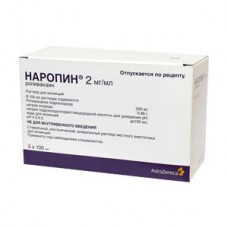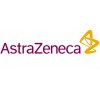Expiration date: 01/2026
Structure and Composition:
Injection. 1 ml contains active substance:
ropivacaine hydrochloride 2, 5 or 10 mg
Excipients: sodium chloride (8.6, 7.5 and 7.1 mg, respectively), hydrochloric acid or sodium hydroxide (to pH 4.6) Water for Injection
in contour cell packages 5 amp. 10 or 20 ml in a stack of cardboard packaging 1.
Description pharmaceutical form:
The clear, colorless solution.
Characteristic:
Naropin solution is a sterile isotonic aqueous solution contains no preservatives and is intended for single use only. pKa ropivacaine - 8,1 distribution coefficient - 141 (n-octanol / phosphate buffer, pH 7.4 at 25 ° C).
Indications:
Anesthesia for surgery:
- epidural block during surgery, including cesarean section
- blockade of major nerves and nerve plexus
- blockade of individual nerves and infiltration anesthesia.
Relief of acute pain:
- prolonged epidural infusion or intermittent bolus, for example, to eliminate post-operative pain or labor analgesia
- blockade of individual nerves and infiltration anesthesia
- prolonged blockade of peripheral nerves
- intraarticular injection.
Relief of acute pain in pediatric patients:
- caudal epidural block in neonates and children up to 12 years of age, inclusive
- prolonged epidural infusion in infants and children up to 12 years of age inclusive.
Contraindications:
- hypersensitivity to the drug
- known hypersensitivity to local anesthetics of the amide type.
Precautions: should be administered the drug impaired elderly patients or patients with serious underlying medical conditions, such as the blockade of intracardiac conduction II and III degrees (sinoatrial, atrioventricular, intraventricular), advanced liver disease, severe hepatic failure, severe chronic renal failure, in the treatment of hypovolemic shock . For these groups of patients regional anesthesia is often preferred. During the big blockages to reduce the risk of serious adverse events is recommended to optimize the patient's condition, as well as to adjust the dose of the anesthetic.
Care should be taken when injecting local anesthetics into the head and neck due to the possible increased incidence of serious side effects.
With intraarticular injection of the drug should be taken when a suspected case of the recent major trauma or joint surgery with the opening of large joint surfaces due to amplify the absorption of the drug and a higher concentration of drug in plasma.
Particular attention should be paid when using the drug in children younger than 6 months due to the immaturity of organs and functions.
Patients who are on a diet with sodium restriction, it is necessary to take into account the content of sodium in the preparation.
Application of pregnancy and breastfeeding:
Pregnancy
There was no effect of ropivacaine on fertility and reproductive function, and teratogenicity. No studies were conducted to assess the possible effect of ropivacaine on fetal development in women.
Naropin should only be used during pregnancy when justified by the clinical situation (in obstetrics use of the drug for anesthesia or analgesia is well founded).
Studies of the effect of the drug on reproductive function were carried out on animals. In rat studies, ropivacaine had no effect on fertility and reproduction in two generations. With the introduction of the maximum doses to pregnant rats increase in offspring mortality was observed in the first three days after birth, possibly because of the toxic effects of ropivacaine on the mother, leading to disruption of the maternal instinct.
Teratogenicity studies in rabbits and rats showed no adverse effects of ropivacaine on organogenesis or fetal development in the early stages. Also during the perinatal and postnatal studies in rats treated with the maximum tolerated dose of the drug, there was no side effects at later stages of fetal development, birth activity, lactation, or the viability of offspring growth. During the perinatal and postnatal comparative studies bupivacaine with ropivacaine it was shown that, unlike the toxic effect of ropivacaine bupivacaine was observed at much smaller doses of the drug at lower concentrations in blood unbound bupivacaine.
Lactation
Not studied the allocation of ropivacaine or its metabolites in breast milk. Based on experimental data, the dose received newborns suspected of 4% of the dose administered to the mother (drug concentration in milk / drug concentration in plasma). The total dose of ropivacaine, acting on the child's breastfeeding, is much smaller doses, which can get into the fetus when administered to the mother during childbirth anesthetic.
If necessary, use during lactation should consider the ratio of the potential benefits to the mother and the possible risk to the infant.
Side effect:
Adverse reactions to Naropin analogous reactions for other local anesthetics of amide type. They should be distinguished from the physiological effects resulting from the blockade of the sympathetic nerves on the background of epidural anesthesia, such as decreased blood pressure, bradycardia or effects associated with the technique of injection such as local nerve damage, meningitis, postdural puncture headache, epidural abscess.
Side effects inherent to local anesthetics
Of the central and peripheral nervous system
Possible violation of neuropathy and spinal cord (anterior spinal artery syndrome, arachnoiditis, cauda equina syndrome), usually associated with the technique of regional anesthesia, rather than with the effect of the drug.
As a result of accidental intrathecal administration of epidural doses of complete spinal block may occur.
There are serious complications of systemic overdose and unintentional intravascular injection of the drug (see. "Overdose" section).
Acute toxicity
Naropin may cause acute systemic toxic reactions when using high doses or rapid increase in the blood concentration of an accidental intravascular injection of the drug or its overdose (see. "Overdose" section).
The most common side effects
It has been reported about the various side effects of the drug, most of which was not due to the influence of the anesthetic used, and the technique of regional anesthesia.
The most commonly (> 1%) had the following side effects, which were regarded as having clinical significance regardless of causal relationship to the use of anesthetic was whether the set: lowering blood pressure *, nausea, bradycardia, vomiting, paresthesia, fever , headache, urinary retention, dizziness, chills, increased blood pressure, tachycardia, hypoesthesia, anxiety.
The incidence of adverse effects were as follows:
Often (> 1/100, <1/10), uncommon (> 1/1000, <1/100), rare (> 1/10000, <1/1000), very rare (<1/10000), including isolated reports.
Often
From the CCC: lowering blood pressure. *
On the part of the digestive tract: nausea.
Often
From the nervous system: paresthesia, dizziness, headache.
From the CCC: bradycardia, tachycardia, hypertension.
On the part of the digestive tract: vomiting **.
With the genitourinary system: urinary retention.
Common: back pain, chills, fever.
Infrequently
From the nervous system: anxiety, symptoms of toxicity of the central nervous system (convulsions, large seizures, paresthesias in perioral area, dysarthria, tongue numbness, visual disturbances, tinnitus, tremor, muscle cramps), hypoesthesia.
From the circulatory system: syncope.
Respiratory system: shortness of breath, difficulty breathing.
General: hypothermia.
Rarely
From the CCC: arrhythmia, cardiac arrest.
Common: allergic reactions (anaphylaxis, angioedema, urticaria).
* Lowering blood pressure often occurs in children.
** Vomiting occurs in children very often.
Dosage and administration:
Naropin should only be used by specialists who have sufficient experience of regional anesthesia, or under their supervision.
Adults and children over 12 years:
In general anesthesia for surgical interventions require higher doses of more concentrated solutions of the drug than with anesthetic for pain. When using anesthetic for the purpose of anesthesia is usually recommended dose of 2 mg / ml. For intra-articular administration of the recommended dose of 7.5 mg / ml.





